Overview
Navigating the process of filing VA disability claims for hypertension can be daunting. We understand that many veterans face challenges in this journey. It’s essential to know the key steps that can make a significant difference in your claim’s success.
- Gathering proper medical evidence is crucial.
- Obtaining a formal diagnosis from a healthcare professional can strengthen your case.
- Avoiding common mistakes is equally important—these can hinder your chances of approval.
Statistics show that veterans who take these steps often see better outcomes. By understanding the claims process and preparing thoroughly, you can enhance your chances of a successful claim.
Remember, you are not alone in this journey. We’re here to help you every step of the way. Take the time to gather your documentation and seek the support you need. You deserve to have your claims addressed with the care and attention they require.
Introduction
Navigating the complexities of VA disability claims for hypertension can feel overwhelming for many veterans. We understand that with a staggering number of claims processed each year, it can be difficult to know where to begin. Understanding the essential steps and strategies to secure the benefits you deserve is crucial.
This article delves into the intricacies of filing a VA disability claim for hypertension, offering valuable insights and practical tips to help streamline the process. It's common to feel uncertain about the path ahead, but rest assured, you are not alone in this journey.
What are the common pitfalls that veterans encounter? How can you effectively overcome these challenges to ensure a successful claim? Together, we will explore these questions, guiding you through the process with care and compassion.
Turnout: Streamlining VA Disability Claims for Hypertension
Turnout is transforming the experience for individuals submitting requests for VA disability for hypertension. By harnessing the power of AI technology and skilled non-legal advocates, this innovative approach simplifies the application process, allowing veterans to access essential support with ease. We understand that navigating the complexities and bureaucratic hurdles can be overwhelming. That’s why Turnout not only speeds up processing times but also alleviates the stress often associated with these procedures. Veterans can look forward to a more compassionate and efficient experience, enabling them to prioritize their health and well-being instead of being bogged down by paperwork.
As of August 2025, the VA has made remarkable strides, handling an unprecedented 2,524,115 disability requests in a single fiscal year. This achievement reflects a commitment to enhancing service delivery. The average time to finalize disability-related requests was 94.8 days, showcasing the effectiveness of the process. Importantly, Turnout is not a legal practice and does not provide legal advice; instead, it employs trained non-legal advocates to support service members. For those seeking tax debt relief, Turnout collaborates with IRS-licensed enrolled agents, ensuring comprehensive support for clients.
With Turnout's AI-powered solutions and specialized assistance, former service members can navigate the application process for VA disability for hypertension with confidence, ensuring they receive the benefits they deserve. As Representative David Valadao aptly noted, 'The VA’s existing claims system is ineffective, generates backlogs, and imposes unnecessary paperwork on service members and their families.' You are not alone in this journey; we're here to help you every step of the way.
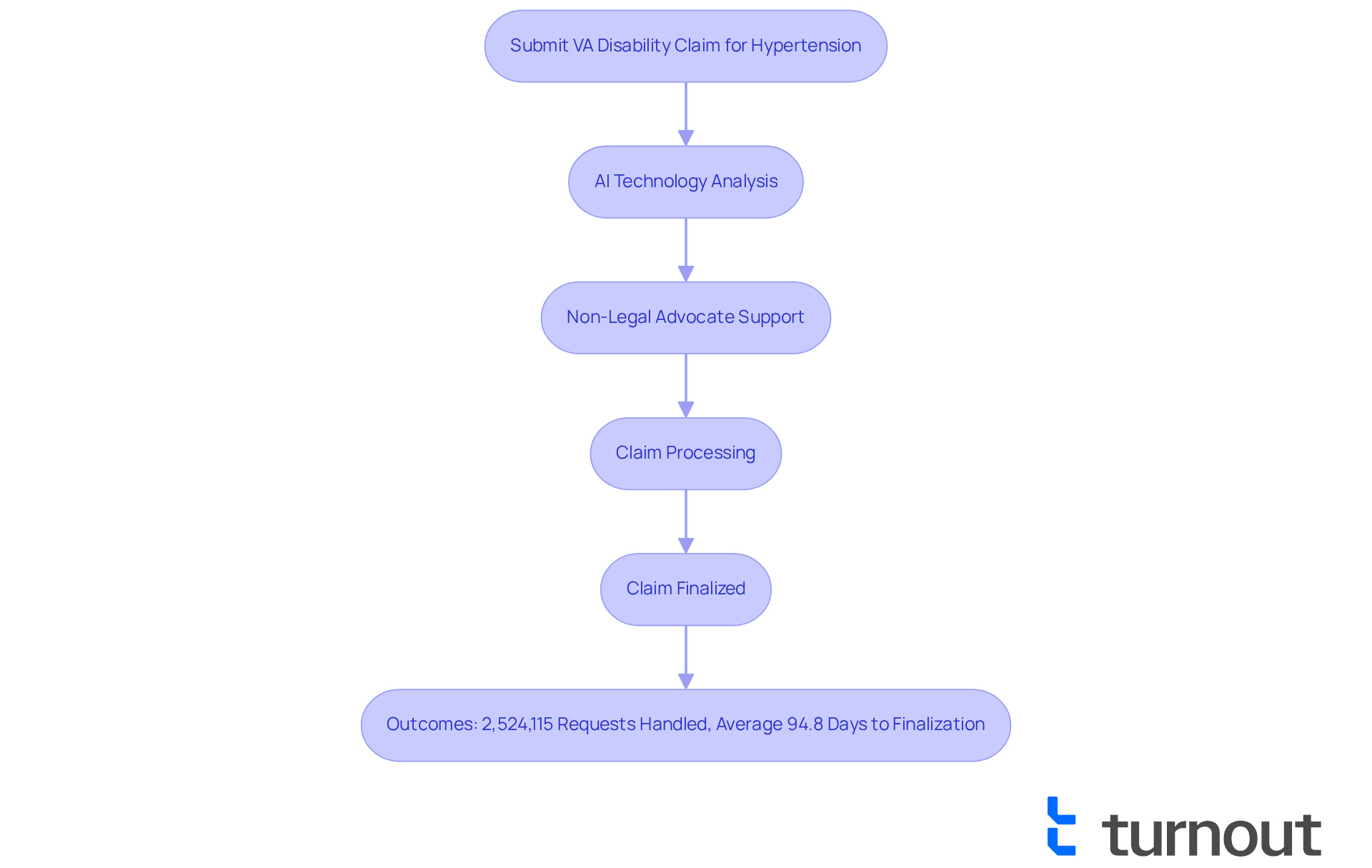
Hypertension: Definition and Impact on Veterans' Health
Hypertension, often referred to as high blood pressure, is a chronic condition that can lead to serious health complications such as heart disease, stroke, and kidney failure. We understand that for former military personnel, the risk of high blood pressure is notably higher. Factors like combat stress, exposure to environmental toxins, and lifestyle changes after service contribute to this elevated occurrence. Recognizing the consequences of high blood pressure is vital for former military members, as it directly affects their quality of life and eligibility for disability assistance.
Research shows that veterans with high blood pressure frequently face additional health challenges, including:
- post-traumatic stress disorder (PTSD)
- diabetes
- sleep apnea
These comorbidities can complicate their health status and potentially increase their overall disability ratings.
The VA recognizes high blood pressure as a significant public health challenge. Disability ratings for this condition can range from 10% to 60%, depending on its severity. A 60% rating is typically assigned when diastolic pressure is primarily 130 or above, highlighting the serious nature of uncontrolled high blood pressure. If former service members are diagnosed with high blood pressure within a year of discharge, they may qualify for an assumed service connection. This makes it essential for them to understand their rights and the application process.
Veterans might also qualify for Total Disability Individual Unemployability (TDIU) if their high blood pressure substantially impacts their ability to maintain employment. To qualify, they must have a disability rating of 60% or higher and demonstrate that their condition is linked to military service.
Understanding the prevalence and impact of high blood pressure is crucial for veterans as they navigate the VA disability for hypertension claims process. This knowledge directly influences their access to necessary benefits and support. Remember, you are not alone in this journey, and we are here to help.

VA Disability Ratings for Hypertension: What Veterans Should Expect
Navigating the VA disability for hypertension ratings can be overwhelming, but understanding them is essential for securing the support you deserve. The VA allocates disability ratings based on the severity of the condition, ranging from 0% to 60%. If you find yourself needing continuous medication to manage your blood pressure, a 10% rating is typically granted. Higher ratings depend on specific blood pressure readings and the symptoms you may experience.
For instance:
- A diastolic pressure between 100 and 109 or a systolic pressure from 160 to 199 may result in a 10% rating.
- Conversely, a diastolic pressure of 130 or higher could elevate your rating to 60%.
It’s important to remember that a diagnosis of high blood pressure must be supported by evidence from two or more readings taken on three separate days.
Moreover, hypertension can often be linked to other conditions, such as PTSD, diabetes, and sleep apnea. This connection may open doors for additional compensation. The VA employs diagnostic code 7101 for assigning VA disability for hypertension related to hypertensive vascular disease.
Understanding these ratings is crucial, as they directly affect the compensation veterans receive and their eligibility for further benefits. As of 2025, monthly compensation amounts vary significantly:
- A 0% rating yields no compensation.
- A 60% rating offers $1,395.93 per month.
Veterans who have successfully navigated the application process frequently emphasize the importance of thorough documentation and regular blood pressure readings. They often share that a well-prepared application can lead to positive outcomes. Remember, you are not alone in this journey; we’re here to help you through every step.
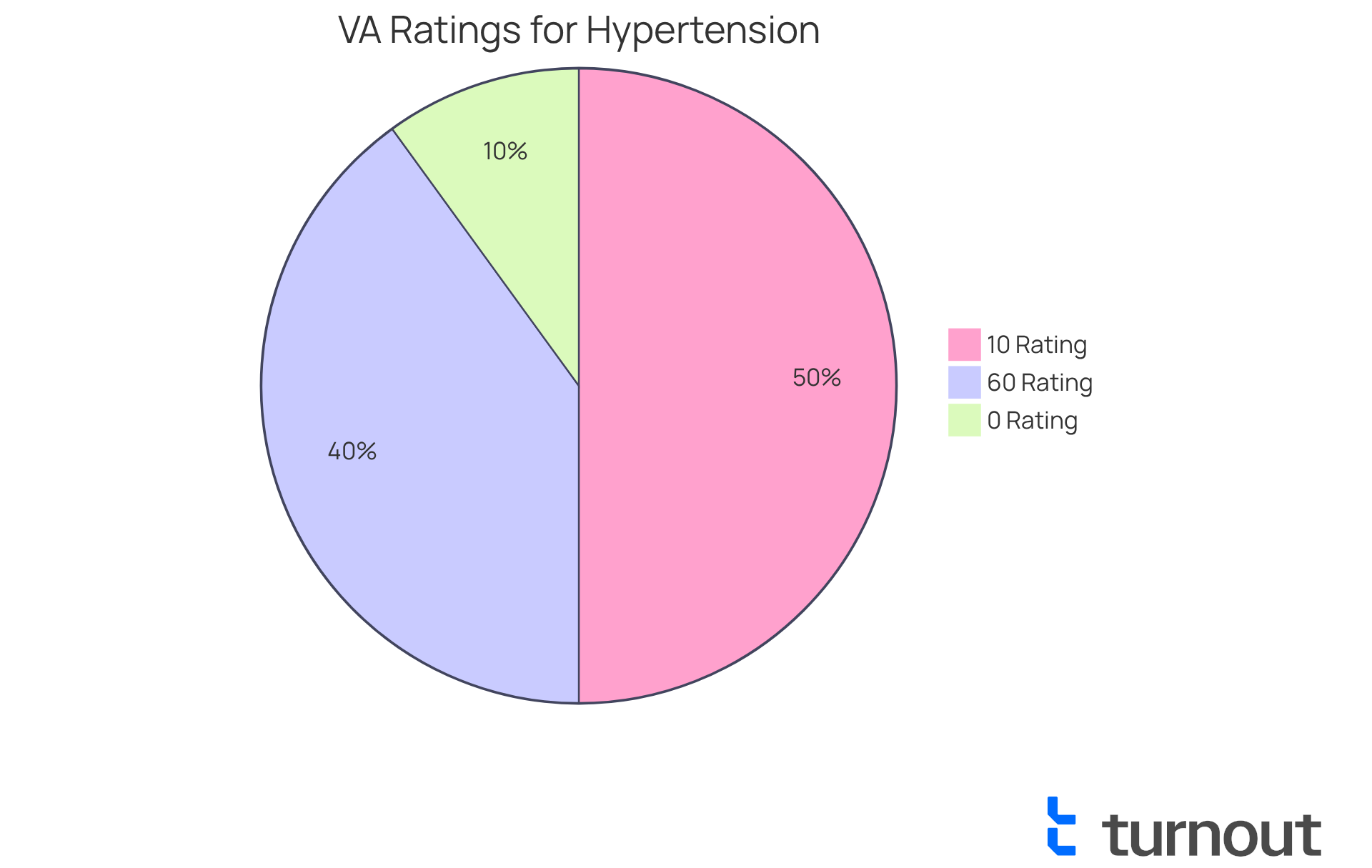
Steps to File a VA Disability Claim for Hypertension
Filing a VA disability for hypertension may seem overwhelming, but we're here to guide you through it. Understanding the steps involved is crucial for your peace of mind and success.
-
Gather Medical Evidence: Start by collecting all relevant medical records. This includes multiple blood pressure readings, treatment history, and any related health conditions. Keeping a comprehensive record of your blood pressure measurements can truly illustrate the seriousness of your condition and the effectiveness of your therapies.
-
Obtain a Formal Diagnosis: It's essential to have a diagnosis from a qualified healthcare provider. This diagnosis is a key piece in establishing a service connection, which is vital for your VA disability for hypertension claim.
-
Complete VA Form 21-526EZ: This form is necessary for applying for disability compensation. It requires detailed information about your medical history and how hypertension impacts your daily life to qualify for VA disability for hypertension. Take your time to fill it out thoroughly.
-
Submit Your Claim: You can file your claim online, by mail, or in person at a VA office. Make sure all supporting documents are included to avoid any delays in processing your claim.
-
Attend the C&P Exam: Be prepared for a Compensation and Pension exam, where your condition will be evaluated. During this exam, be specific about how hypertension affects your daily life and mention any related symptoms or complications that could support your claim for VA disability for hypertension. This exam is crucial for determining your disability rating.
-
Follow Up: Keep an eye on the status of your request and respond promptly to any inquiries for further information. Regular follow-ups can really help expedite the process.
Many veterans share their experiences navigating the benefits process, emphasizing the importance of thorough documentation and determination. One individual noted, "The process can feel overwhelming, but having all my medical records organized made a significant difference."
The time it takes to compile medical evidence for VA applications can vary. However, taking the initiative to collect and organize your documents can simplify the procedure. Many former service members find that with proper preparation, they can navigate the system more effectively and obtain the benefits they deserve. Remember, maintaining a comprehensive record of your blood pressure measurements and symptoms can greatly enhance your chances of receiving VA disability for hypertension. You are not alone in this journey.
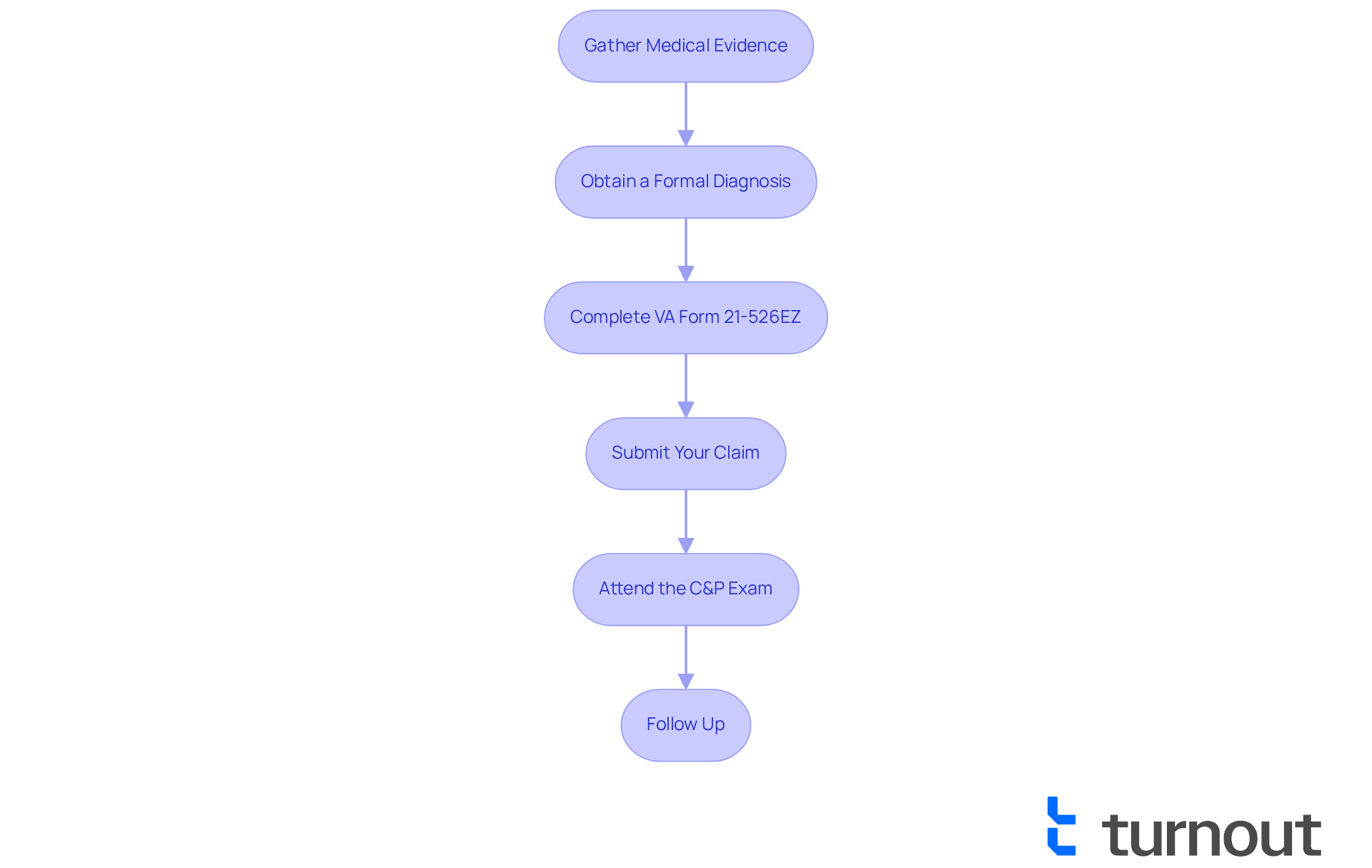
Common Mistakes to Avoid When Filing for Hypertension Benefits
When filing for VA disability for hypertension, we understand that veterans may face several challenges. It's important to avoid these common mistakes:
-
Insufficient Medical Documentation: Failing to provide comprehensive medical records can lead to claim denials. Claims that lack detailed blood pressure readings, treatment history, and a clear connection linking hypertension to military service are particularly vulnerable. We encourage veterans to keep a record of their blood pressure measurements over time, incorporating both healthcare provider and at-home readings, to enhance their documentation. Additionally, acquiring a robust medical opinion that clearly links the disability to military service is essential for a successful request.
-
Missing Deadlines: It's common to feel overwhelmed by deadlines, but being aware of them is crucial to avoid losing your eligibility. A single missed deadline can have long-lasting repercussions, including the potential loss of benefits. Veterans should utilize reminders and notifications, including automated deadline management tools, to effectively manage their deadlines and ensure that important tasks are not overlooked.
-
Neglecting to Establish Service Connection: Clearly demonstrating how your hypertension is linked to your military service is vital. Offering a robust nexus letter from a healthcare provider can clarify this connection and strengthen the reliability of your assertion. Veterans should also consider filing for secondary conditions that may arise from their primary service-related disabilities, as these can impact overall disability ratings.
-
Inaccurate Information: We know that ensuring all information provided is accurate and consistent can be daunting, but it is essential to prevent complications. Inconsistent statements or incomplete applications can lead to delays or denials. Veterans should verify their submissions and ensure that all documentation is well-structured and thorough, as providing inconsistent statements can greatly endanger their requests.
By steering clear of these obstacles and applying these practical suggestions, veterans can greatly enhance their prospects of obtaining VA disability for hypertension-related benefits they rightfully deserve. Remember, you are not alone in this journey, and we're here to help.
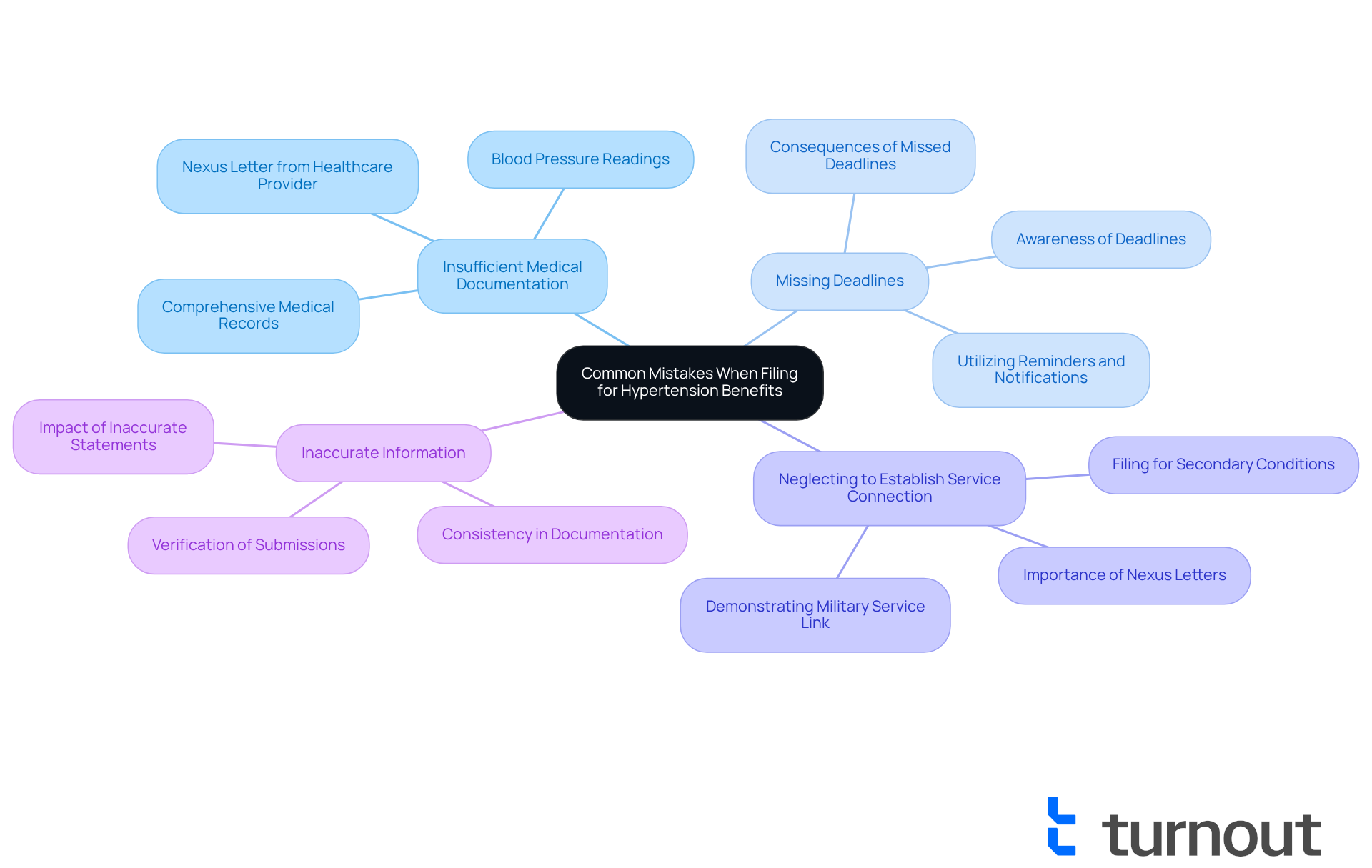
Tips for Strengthening Your VA Disability Claim for Hypertension
To strengthen your VA disability claim for hypertension, consider the following tips:
- Keep Detailed Records: We understand that keeping track of your health can be overwhelming. However, maintaining a comprehensive log of your blood pressure readings and any related symptoms is crucial. Consistent documentation is essential, as the VA requires multiple readings taken on different days to establish a diagnosis.
- Obtain a Nexus Letter: It’s important to secure a personalized letter from your healthcare provider that connects your hypertension to your military service. This letter should mention your medical history and the timeline of your symptoms, offering crucial support for your request.
- Utilize the DBQ: Completing the Disability Benefits Questionnaire (DBQ) accurately is key. This structured form helps document your diagnosis, severity, and functional impact, aligning your evidence with the VA's criteria for evaluation for VA disability for hypertension.
- Seek Help: Navigating this process can be challenging. Think about partnering with a specialist who can assist you. Their expertise can help you avoid potential pitfalls and improve your chances of a successful outcome.
- Leverage Lay Statements: Gathering statements from friends or family that corroborate your symptoms and limitations can be beneficial. These lay statements should focus on specific observations and avoid medical conclusions, offering additional context and support for your assertion by highlighting the real-world impact of your condition.
- Prepare for the C&P Exam: It’s common to feel anxious about the Compensation & Pension (C&P) exam. Be ready to discuss how high blood pressure impacts your daily life. Clear communication regarding your symptoms and their effects can greatly affect the result of your request.
- Stay Informed: Keeping up with the latest updates on VA policies and procedures related to blood pressure-related requests is important. Understanding the current landscape can help you make informed decisions throughout the process.
- Document Secondary Conditions: If you have other health issues related to your hypertension, documenting these as well can strengthen your case. Establishing connections between conditions can enhance your overall argument.
- Respond Promptly: We know that waiting can be stressful. Quickly addressing any requests from the VA for additional information or documentation can lessen uncertainty and assist in advancing your request.
- Review and Appeal: If your request is denied, don’t hesitate to appeal. Options include filing a Supplemental Claim with new evidence, requesting a Higher Level Review for error correction, or appealing to the Board. Gather additional evidence, including updated medical records and a strong nexus letter, to support your case in the appeal process.
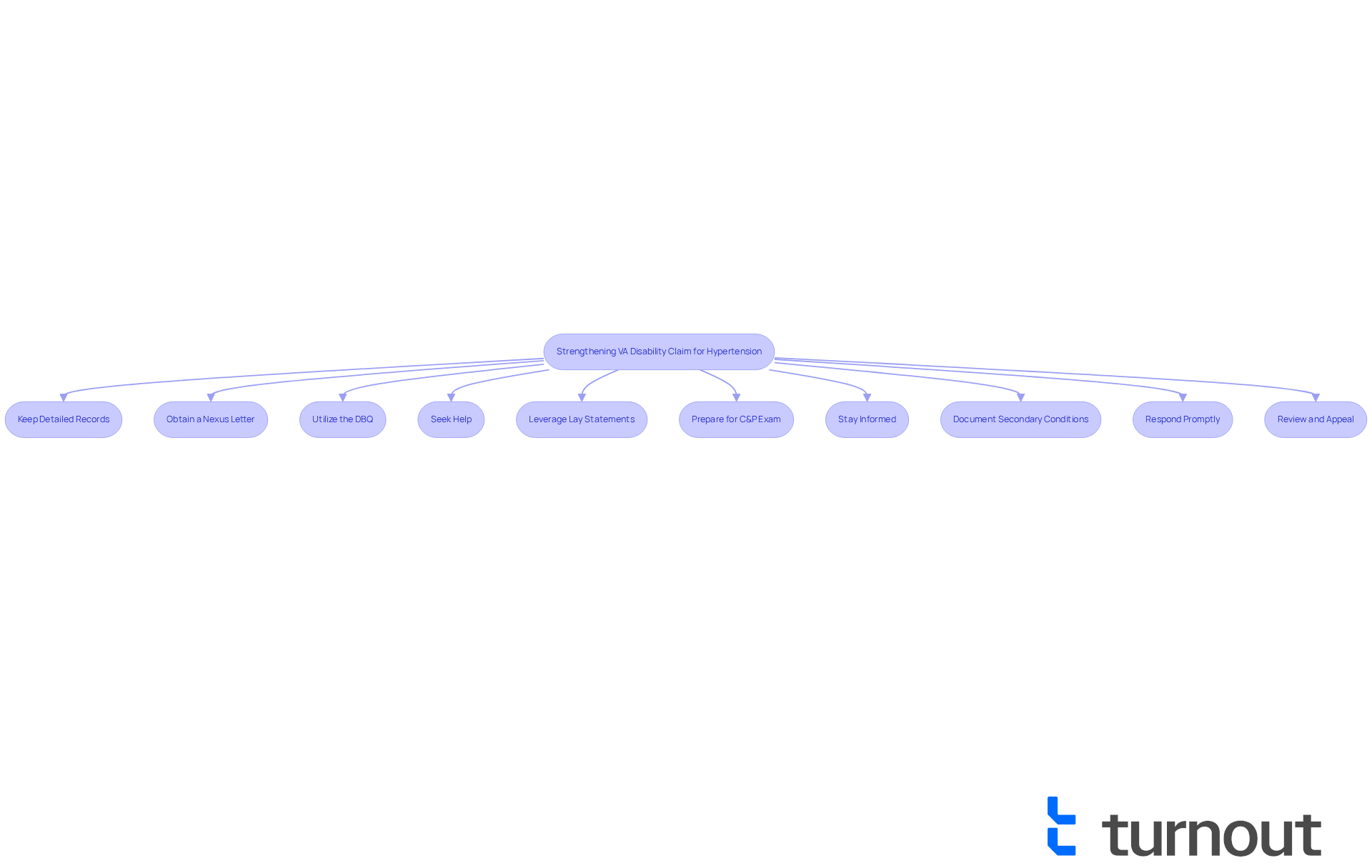
Navigating the Appeals Process for Denied Hypertension Claims
If your request for VA disability for hypertension has been rejected, it’s completely understandable to feel frustrated and uncertain about what to do next. You have the right to contest this outcome regarding VA disability for hypertension, and we’re here to guide you through the appeals process.
-
Review the Denial Letter: Take a moment to understand the reasons for the denial. This knowledge is crucial as it allows you to address these points directly in your appeal.
-
File a Notice of Disagreement (NOD): By submitting an NOD, you are formally contesting the decision. This is an important step in asserting your rights.
-
Gather Additional Evidence: Collect any new medical records or documentation that supports your claim. This evidence can make a significant difference in your appeal.
-
Request a Hearing: You may choose to have a hearing before a Veterans Law Judge. This is an opportunity to present your case in person, which can be empowering.
-
Follow Up: Stay engaged with the VA throughout this process. Regularly checking in can help ensure that your appeal is processed in a timely manner.
Remember, you are not alone in this journey. We understand that navigating the appeals process can be challenging, but with each step, you are advocating for yourself and your needs.
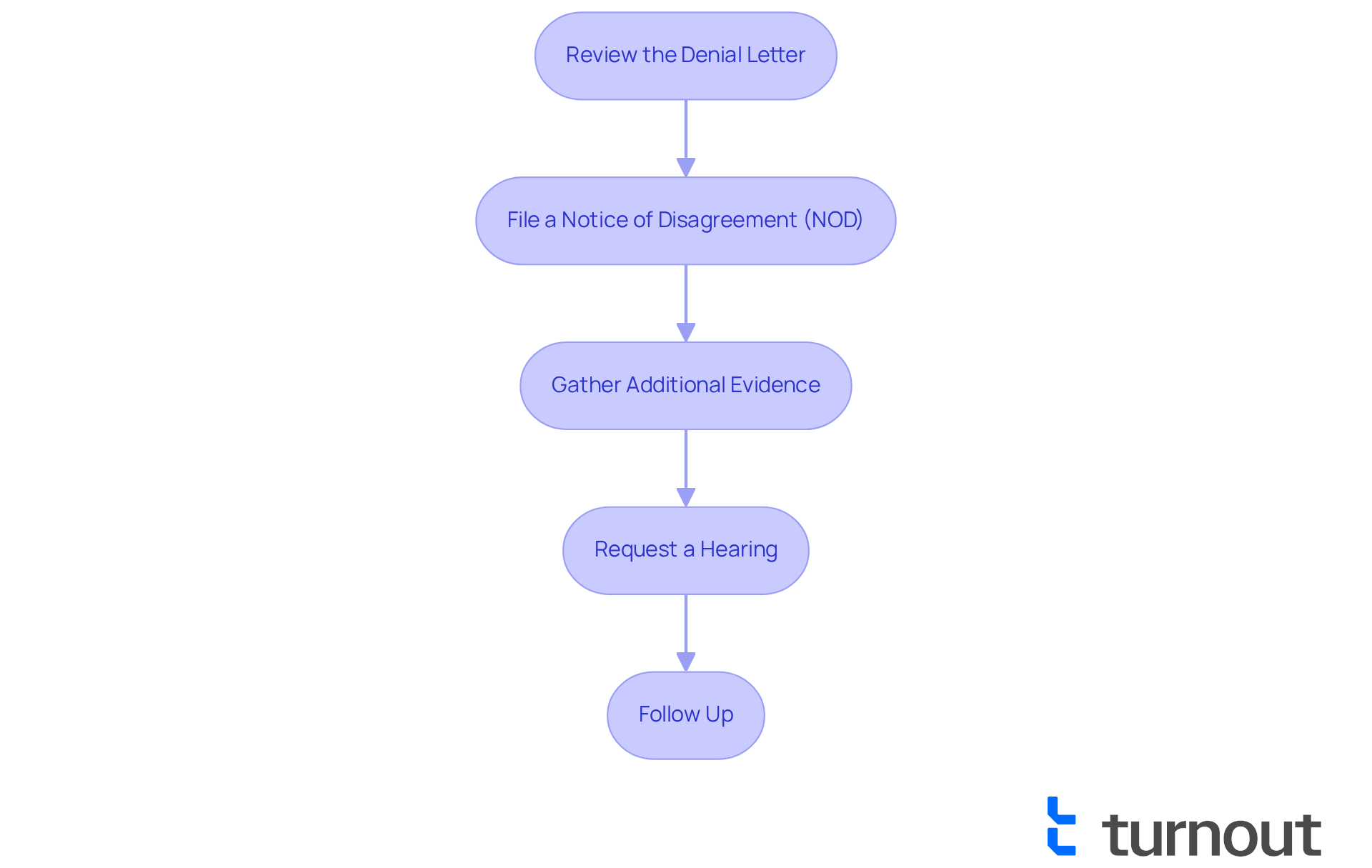
Presumptive Conditions: How They Relate to Hypertension Claims
According to the PACT Act, high blood pressure is recognized as a presumptive state for individuals exposed to certain environmental dangers, including Agent Orange. This categorization allows former military personnel to bypass the often complex task of proving a direct link between their military service and VA disability for hypertension due to their high blood pressure. Instead, the VA assumes that the condition is connected to service if the former service member meets specific criteria, significantly simplifying the claims process.
It's important to note that around 37% of former military personnel experience high blood pressure, making it the most common chronic condition within this group. Many former service members may qualify for benefits under this presumptive status without needing extensive documentation. For instance, those who served in Vietnam or other designated locations during specific periods are automatically considered for VA disability for hypertension.
The impact of this presumptive status is truly significant. Veterans who have successfully navigated the claims process often share that understanding their eligibility under the PACT Act has led to faster access to benefits. This streamlined approach not only alleviates the burden of proof but also enables former service members to receive the compensation they deserve more efficiently. As a result, many former service members are now obtaining the financial assistance needed to manage their health challenges effectively.
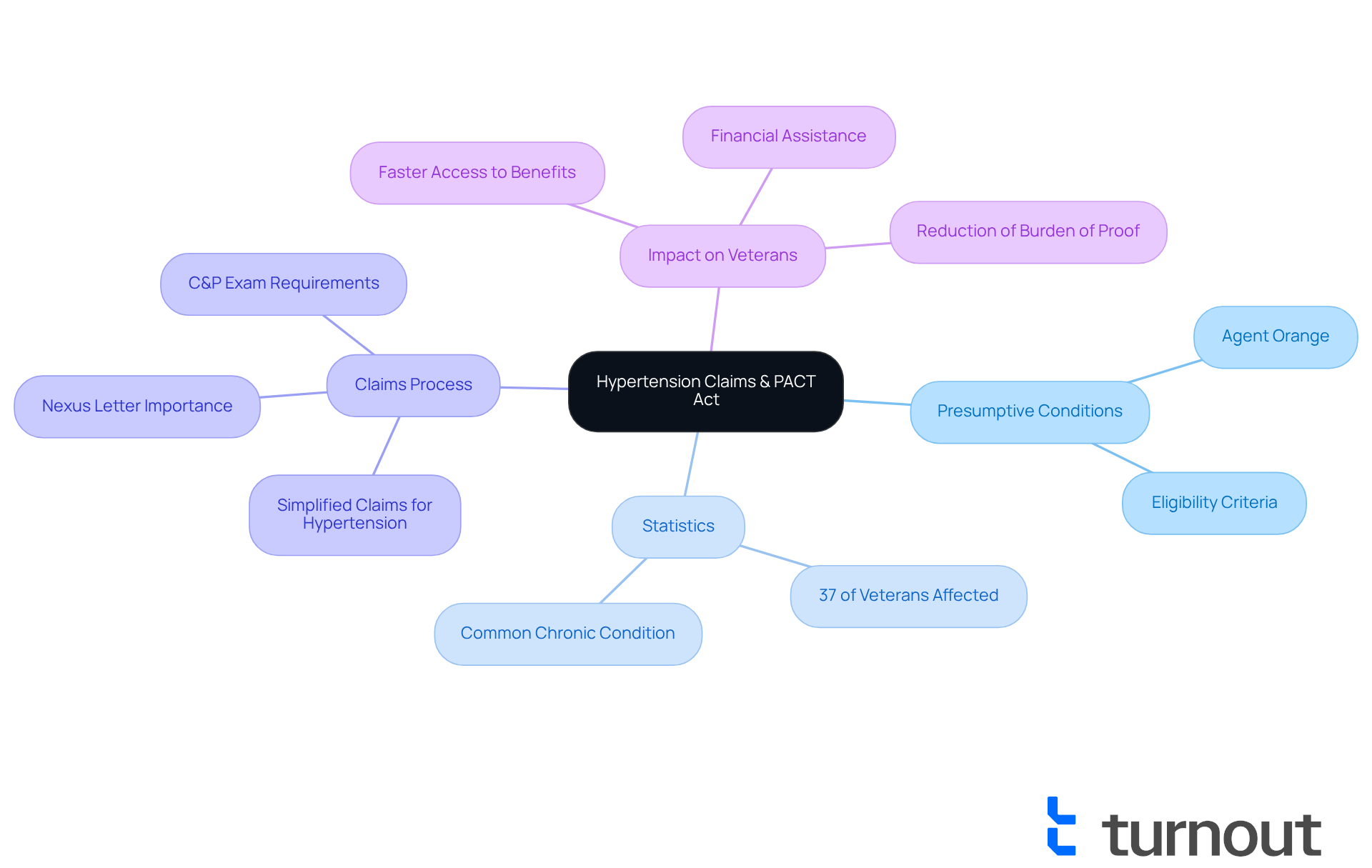
Secondary Conditions Associated with Hypertension in Veterans
High blood pressure can lead to various secondary issues, which may make former service members eligible for VA disability for hypertension. It’s important to understand these connections, as they can significantly impact your health and well-being.
-
Heart Disease: High blood pressure significantly increases the risk of coronary artery disease (CAD), the most prevalent type of heart disease in the U.S. It’s concerning to note that studies indicate over 37 percent of veterans are affected by hypertension, which makes them particularly vulnerable to heart-related issues. The standards for VA disability for hypertension vary in severity, highlighting the need to comprehend how these issues connect to disability claims.
-
Kidney Disease: Chronic kidney disease can develop when hypertension damages the blood vessels in the kidneys. This situation can severely impair kidney function and may lead to kidney failure if not managed properly. It’s crucial to monitor your health closely.
-
Stroke: Elevated blood pressure is a major risk factor for strokes, which can occur when blood flow to the brain is obstructed. Hypertension can either occlude blood vessels or cause them to rupture, leading to hemorrhagic strokes.
With about 48.1% of U.S. adults experiencing high blood pressure, this issue is widespread among veterans. We encourage you to carefully document any related health problems when submitting your requests, as these may make you eligible for additional compensation. Establishing a connection between high blood pressure and these conditions often requires a nexus letter, which is essential for supporting claims for VA disability for hypertension.
Moreover, former service members may also qualify for Total Disability based on Individual Unemployability (TDIU) benefits due to secondary conditions associated with high blood pressure. Efficient oversight and thorough record-keeping are crucial for a successful reimbursement process. Remember, you are not alone in this journey; we’re here to help.
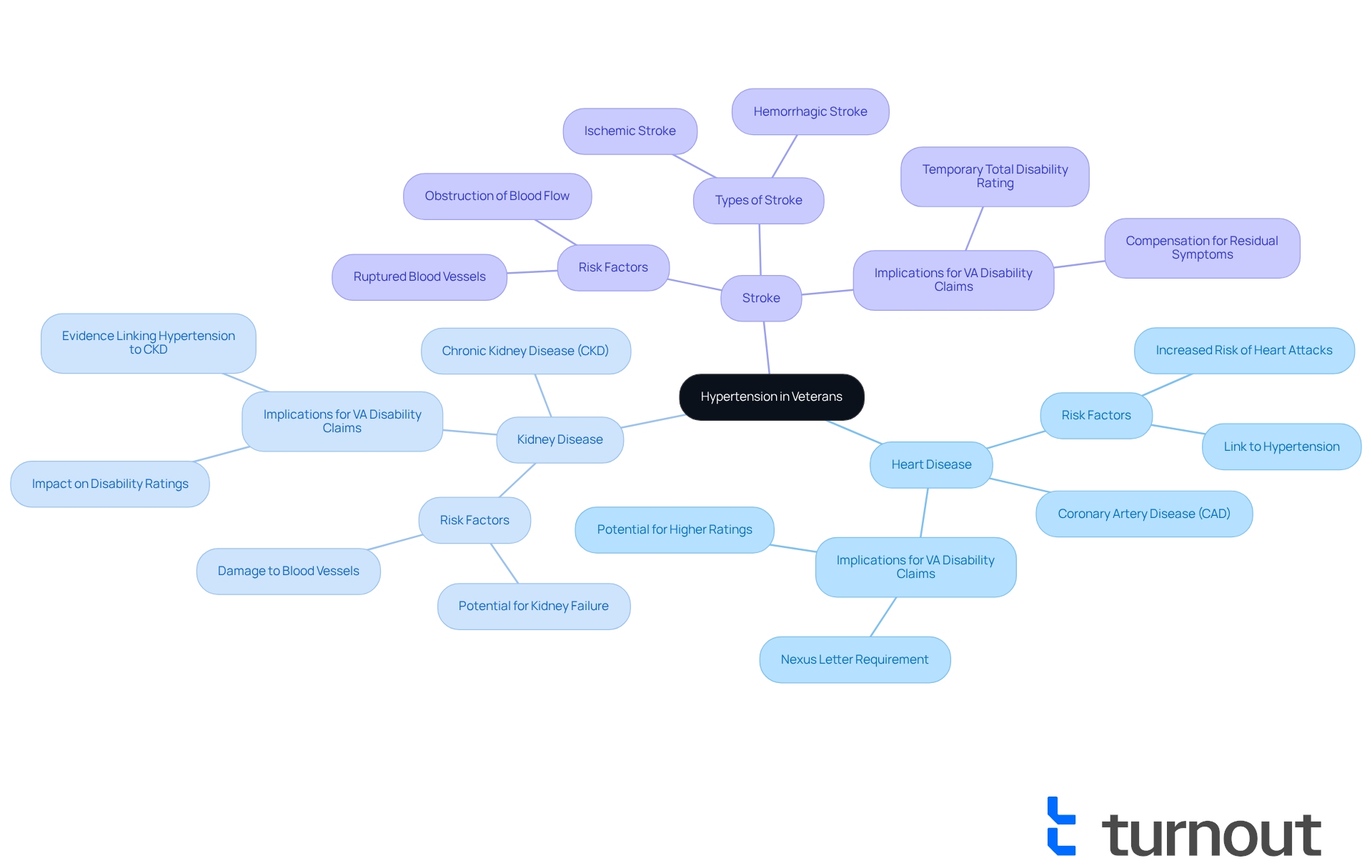
Resources for Veterans Seeking Assistance with Hypertension Claims
Navigating the process of filing claims for VA disability for hypertension can be overwhelming. We understand that many veterans face challenges in securing the VA disability for hypertension benefits they deserve. Thankfully, there are valuable resources available to support you on this journey.
- VA.gov: This official VA website is a vital starting point, offering comprehensive information on filing claims and accessing benefits. It's designed to help you understand your options and take the first steps toward assistance.
- Veterans Service Organizations (VSOs): Organizations like the Disabled American Veterans (DAV) and the Veterans of Foreign Wars (VFW) provide complimentary support with applications. Many veterans have reported positive experiences and expedited processing times when utilizing their services. Their expertise can significantly enhance the likelihood of favorable results.
- Turnout: With Turnout's AI-driven platform, you can receive tailored assistance that makes navigating the often intricate claims process easier and more confident.
- Local VA Offices: Visiting your local VA office can also provide in-person assistance. These offices are equipped to offer customized guidance and address any specific inquiries you may have about your application.
By leveraging these resources, you can enhance your chances of successfully navigating the VA claims system. Remember, you are not alone in this journey. We’re here to help you secure the benefits you deserve.
Conclusion
Navigating the VA disability claims process for hypertension can feel overwhelming. We understand that this journey is complex and often daunting. However, by familiarizing yourself with the essential steps and available resources, you can significantly ease your experience.
Comprehensive documentation is vital. Establishing a clear service connection and avoiding common pitfalls can enhance the likelihood of a successful claim. Innovative platforms like Turnout can also streamline the process, ensuring that veterans receive the support they deserve without unnecessary stress.
Key insights to keep in mind include:
- The importance of maintaining detailed medical records
- Obtaining a formal diagnosis
- Leveraging resources such as Veterans Service Organizations and local VA offices
- Understanding how hypertension impacts your overall health
- Recognizing the potential for associated secondary conditions, which can open doors to further compensation and support
Remember, you are not alone in this journey toward securing VA disability benefits for hypertension. By staying informed and utilizing the resources available to you, you can navigate this process with confidence. It’s crucial to advocate for yourself and seek assistance whenever needed. Your sacrifices in service deserve recognition and support, paving the way for a healthier future.
Frequently Asked Questions
What is Turnout and how does it assist veterans with VA disability claims for hypertension?
Turnout is an innovative service that simplifies the application process for VA disability claims related to hypertension by utilizing AI technology and trained non-legal advocates. It aims to streamline the experience, reduce processing times, and alleviate stress for veterans navigating the complex claims system.
What recent achievements has the VA made regarding disability requests?
As of August 2025, the VA processed a record 2,524,115 disability requests in a single fiscal year, with an average processing time of 94.8 days for finalizing these requests, indicating significant improvements in service delivery.
Does Turnout provide legal advice?
No, Turnout is not a legal practice and does not provide legal advice. It employs trained non-legal advocates to assist service members with their claims.
What is hypertension and how does it affect veterans' health?
Hypertension, or high blood pressure, is a chronic condition that can lead to serious health issues such as heart disease, stroke, and kidney failure. Veterans are at a higher risk due to factors like combat stress and lifestyle changes, which can impact their quality of life and eligibility for disability assistance.
What additional health challenges do veterans with high blood pressure often face?
Veterans with high blood pressure frequently experience other health issues, including post-traumatic stress disorder (PTSD), diabetes, and sleep apnea, which can complicate their overall health status and disability ratings.
How does the VA rate disability for hypertension?
The VA assigns disability ratings for hypertension based on severity, ranging from 0% to 60%. A 10% rating may be given for those requiring continuous medication, while a 60% rating is typically assigned for a diastolic pressure of 130 or higher.
What are the compensation amounts for different disability ratings related to hypertension?
As of 2025, the compensation amounts vary by rating: a 0% rating yields no compensation, while a 60% rating provides $1,395.93 per month.
What documentation is important for veterans applying for VA disability for hypertension?
Veterans should ensure they have thorough documentation, including evidence from two or more blood pressure readings taken on three separate days, to support their diagnosis and application for benefits.
What should veterans know about qualifying for Total Disability Individual Unemployability (TDIU) related to hypertension?
Veterans may qualify for TDIU if their hypertension significantly impacts their ability to maintain employment, requiring a disability rating of 60% or higher and a demonstrated connection to military service.
How can veterans get support during the VA disability claims process for hypertension?
Veterans can seek assistance from organizations like Turnout, which provide support and guidance throughout the application process, helping them navigate the complexities and ensuring they receive the benefits they deserve.




